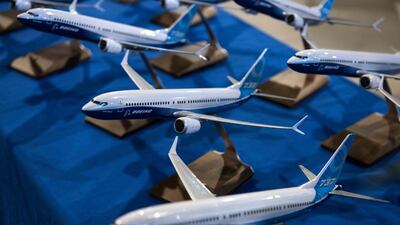The tragic crash this week of Lion Air flight JT 610 into the sea off Jakarta with 189 people on board has put the spotlight on Boeing's 737 Max 8. Even as the cause for the crash is yet to be determined, and Boeing said its ready to help investigators, the narrow-body aircraft is an iconic symbol of the aviation industry.
What is the 737 Max 8?
The aircraft is part of Boeing’s 737 Max family, and went into service in 2017. The single-aisle plane can seat as many as 210 passengers and is powered by two CFM LEAP-1B engines. The 737 Max 8 model is 39.52 metres long and has a 35.9m wingspan. The 737 Max 8 competes with Airbus’s A320neo range of aircraft and has a list price of $117.1 million (Dh429m).
What is the appeal of 737 Max?
The aircraft is used by more than 100 airlines globally and is popular with low-cost companies such as the Indonesian budget airline Lion Air as well as other big operators globally. The jet's selling points are fuel efficiency, with more in cost savings than other narrow-body aircraft, and reliability, allowing operators to deploy the jet frequently with a quick turnaround time.
Technologically, the 737 Max incorporates new fly-by-wire systems for its primary control surfaces, instead of clunky manual controls, resulting in weight savings. “The new advanced technology winglets also help slash fuel burn by up to 3 per cent which saves airlines hundreds of millions of dollars and gallons of fuel each year,” said Saj Ahmad, chief analyst at Strategic Aero Research. Fuel economy is particularly important for low cost airlines that operate a slew of flights across their ever-expanding networks.
These advantages make the 737 the “airplane of choice among operators who are looking to hedge their bets against a backdrop of rising fuel prices,” said Mr Ahmad.
Turkish Airlines, which has more than 300 aircraft in service, has leveraged the extended reach of narrow-body aircraft to service destinations in Africa, while flydubai is now operating a daily service between Dubai and Helsinki.
How crucial is the 737 Max to Boeing?
Boeing has an order backlog of 4,654 planes for the aircraft from more than 100 customers globally including India’s SpiceJet, China Southern Airlines, Virgin Australia, American Airlines, Air Canada, Ethiopian Airlines and Turkish Airlines, among many others. Lion Air placed a $22.4 billion order for 230 737 Max aircraft in 2012.
The 737 Max model is Boeing's fastest selling airplane family in its 102-year history. “Its importance cannot be understated. It's a high volume produced machine with spectacular margins for the company,” said Mr Ahmad.
A 737 takes off every 2.5 seconds somewhere around the world and, despite the tragic Lion Air crash, “the indisputable fact is that the 737 family is one of the safest airplanes in commercial aviation history,” he added.

